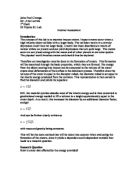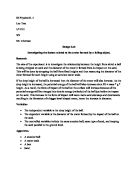Apart from that, because we used slotted mass as our dropped object, it indicates that we will have constant diameter of the craters. This is because no wonder at any point the slotted mass was dropped; it will give us the constant surface area of the craters, which is circle. But as mentioned before, the depth of craters will be varied because it really depends on the height at which it was dropped.
The hypothesis above was decided by considering the potential energy (PE), kinetic energy (KE), conservation of energy and by using impulse concept. Based on the theory, we know that the higher the height, the more its potential energy (PE) and it is also followed by kinetic energy. The kinetic energy will increase (KE) as potential energy increase. Assuming the energy throughout the dropped is conserved which indicates that PE is equal to KE and no energy loses to the surroundings. The velocity of the slotted mass dropped at each height and it impulse can be obtained. It leads that the greater impulse of the dropped slotted mass, the larger the depth of the craters and thus we presuppose that the larger its volume. The investigation was repeated by varying the height when dropping the slotted mass and all the results were tabulated and calculated.
Theory:
Potential energy; potential is a term applied to a place or position, rather than to a particular object. The potential of a point is defined as the potential energy per unit mass of an object. While, potential energy is defined as the stored ability of a body to do work as a result of its position or shape.
Kinetic energy refers to ability to do work as a result of its motion. As we known, kinetic itself is always associated with movement. Whereas, impulse refers to the product of the force F times the time ∆ t over which the force acts.
When the potential energy is increased, at the same time kinetic energy will increase too in virtue of its motion. If energy is conserved which indicates that PE is equal to KE and no energy loses to the surroundings. The velocity of the slotted mass dropped at each height and it impulse can be obtained. It leads that the greater impulse of the dropped slotted mass, the larger the depth of the craters and thus the larger its volume.
Diagram:
Apparatus:Slotted mass (100g and 300g), retort stand, meter ruler, basin, G-clamp and sand.
Variables:
- Dependent Variable : The depth of craters
- Independent Variable : The height of dropped object
- Constant Variable : The mass of slotted masses
Procedure / Method:
- The apparatus as shown in the diagram was set up.
- The sand is poured into a basin until it fulfills the basin. Then, the 300 g slotted mass was placed on the surface of the sand.
- After that, a meter ruler is clamped to a retort stand and it then adjusted so that the ruler will touch the sand’s surface.
- Experiment was started. The 100 g of slotted mass was dropped 2 cm from the other slotted mass surface with the intention that the 100 g slotted mass will bump with 300 g slotted mass which was placed on the sand surface. As the result, the craters will exist.
- The depth and diameter of the craters were measured by using meter ruler.
- Step 4 and 5 were repeated by varying the height when dropping the slotted mass
- This experiment was repeated in order to obtain an accurate result.
- All the data that gathered from this experiment were tabulated.
- The graph of the depth of craters (volume) against height of dropped slotted mass was sketched.
Table of Values:
Analysis of Data:
The shape of slotted mass is cylinder. That is mean we can calculate the volume of slotted mass by using the formula below:
Calculation for the Volume of Craters:
- First Reading Calculation
Diameter of slotted mass = 3.8 ± 0.05 cm
Radius, r = 1.9 ± 0.05 cm
∏ = constant value, 22/7
- Second Reading Calculation
Diameter of slotted mass = 3.8 ± 0.05 cm
Radius, r = 1.9 ± 0.05 cm
∏ = constant value, 22/7
- Third Reading Calculation
Diameter of slotted mass = 3.8 ± 0.05 cm
Radius, r = 1.9 ± 0.05 cm
∏ = constant value, 22/7
- Fourth Reading Calculation
Diameter of slotted mass = 3.8 ± 0.05 cm
Radius, r = 1.9 ± 0.05 cm
∏ = constant value, 22/7
Calculation of Uncertainties for the Volume of the Craters:
In order to calculate the uncertainties for the volume of the craters, we can use the formula below:
- First Reading Calculation
- Second Reading Calculation
- Third Reading Calculation
- Fourth Reading Calculation
Thus, based on the calculation above, the volume of craters:
Theory (Graph):
The volumes of the craters are clearly proportional to the depth of the craters.
Volume of the Craters of Slotted Mass = ∏ r ²d
Or, we can say that:
Volume of the Craters of Slotted Mass = k d, k is constant
The value that holds by ∏ r ² is constant due to the diameter; r and ∏ have constant values. This is because no wonder at any point the slotted mass was dropped; it will give us the constant surface area of the craters, which is circle. But as mentioned before, the depth of craters will be varied because it really depends on the height at which it was dropped.
Thus, in order to sketch the graph of the volume of craters against height of dropped slotted mass, we can represent the y-axis or volume of craters by using the depth of craters itself.
Calculation of the Graph:
In order to sketch the graph, we need to find the average or mean of first, second, third and fourth reading.
- Mean of the Reading (in 1 decimal place)
Centroid:
Height (x – axis) = 2.00 + 4.00 + 6.00 + 8.00 + 10.00 + 12.00
6
= 7.00 ± 0.05
Depth (y – axis) = 0.28 + 0.43 + 0.58 + 0.73 + 0.88 + 1.03
6
= 0.66 ± 0.05
Evaluation / Discussion:
Based on the graph that we obtained, we can say that the height of dropped slotted mass is proportional to the depth of craters. Or in other words, we can say that the depth of craters is also proportional to the volume of craters. Once the depth of craters increased, as the result the volume of craters will increase too. We can see that pattern in the table of the volume of the craters above and from the depth of craters itself.
Actually, what we can say about this experiment is the result that we obtained is tremendously precise. This is based on the graph that we sketched. We got such a precise graph because all the point was fit into the straight line graph. But we still encountered with some problem while conducting this investigation. The problems are:
- Firstly, the scale for meter ruler was not sensitive enough. This leads to results being in accurate due to the results being hard to get right. However, this inaccuracy is a systematic error because it would affect all the results. We need to take the reading for two decimal places in order to ensure that it is precise
-
Besides that, we also faced with the problem in which the laboratory apparatus that we used is in the unsatisfied condition. Actually, many laboratory apparatus is already outdated. For example, the scale is not accurate or precise than it supposed to be.
There are several ways to overcome these problems from occurred again. We can prevent it by making some improvements:
- In order to get an accurate result we should use the laboratory apparatus which in the best condition.
- The experiment should be repeated for many times. This is because we can take the mean of all the reading in order to get accurate result.
Conclusion:
- Hypothesis is valid and accepted.
- At the end of the experiment, we realized that the correlation between the depth of craters and the height of dropping slotted mass is the height of dropped slotted mass is proportional to the depth of craters. Or in other words, we can say that the depth of craters is also proportional to the volume of craters. Once the depth of craters increased, as the result the volume of craters will increase too.
Contribution:
- I contributed some notion about how we will conduct this experiment in the early discussion.
- Besides that, I also surf the internet in order to get some information about this experiment.
- I tried to find the method that we were going to use in order to carry out this experiment from the reference books in library.
________________________________________________________________________
-








